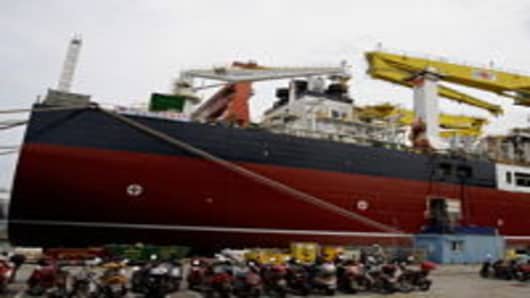South Korea’s three biggest shipbuilders – Hyundai, Daewoo and Samsung – are discussing a joint bid for French group Gaztransport & Technigaz valued at about €1 billion ($1.3 billion), aiming to head off a Chinese challenge, according to people close to the talks.
Hyundai Heavy Industries, the world’s biggest shipbuilder by sales, Daewoo Shipbuilding & Marine Engineering and Samsung Heavy Industries are in talks to team up to bid for the French engineering firm, which specialises in cargo containment systems for high-end liquefied natural gas carriers.
The South Korean shipbuilders are the dominant players in the LNG ship market but they are facing a growing challenge from Chinese rivals.
Three GTT shareholders were understood late last year to have held initial discussions with bankers about a possible sale, which is drawing interest from Chinese companies as well, according to an industry official. The Korean groups hope to block any Chinese interest as they attempt to stay ahead of the rival yards.
The three shareholders – GDF Suez, the world’s biggest utility by sales, French oil firm Total and US buy-out fund Hellman & Friedman – are looking to unload their stakes to tap rising demand for LNG in the wake of the Fukushima nuclear disaster in Japan last March.
“Talks to buy the company started in earnest late last year. Should a Chinese firm take over the company, that would reduce our technology gap with China and could put us at a disadvantage,” said the industry official.
However, a solo bid for GTT would be financially difficult for a Korean shipbuilder as the industry remains in a slump with little sign of recovery.
South Korea’s shipbuilders currently each pay GTT about $10 million on average in royalties for each LNG vessel as the French company provides the core technology for LNG containment systems. An LNG vessel typically costs about $200m. Last year, South Korean shipbuilders received orders for about 40 LNG ships, accounting for more than 70 percent of global orders.
The South Korean groups have developed their own technology for LNG cargo containment but many shipowners still prefer GTT’s technology because it is internationally established.
Korean shipbuilders still have the upper hand in general in the shipbuilding industry but Chinese operators are catching up fast, according to analysts, especially in the lower-end segments such as bulk ships.
“Korean companies are still much more advanced” with technology that at this point it would take China about five years to catch up to, said Hur Sung-duck at Hi Investment Securities, “but it is still bad news for them if a Chinese firm acquires GTT.”
Mr Hur expects the shipbuilding market to remain sluggish in the first half of the year because of financing difficulties related to Europe’s debt crisis, before potentially recovering in the second half if Europe’s woes ease.
Nevertheless, the LNG vessel market has been a relative bright spot, compared with a draught of orders for bulk ships and container ships, as a greater reliance on imported gas by Japan after last year’s earthquake has helped restore to use nearly all the world’s LNG tankers.


